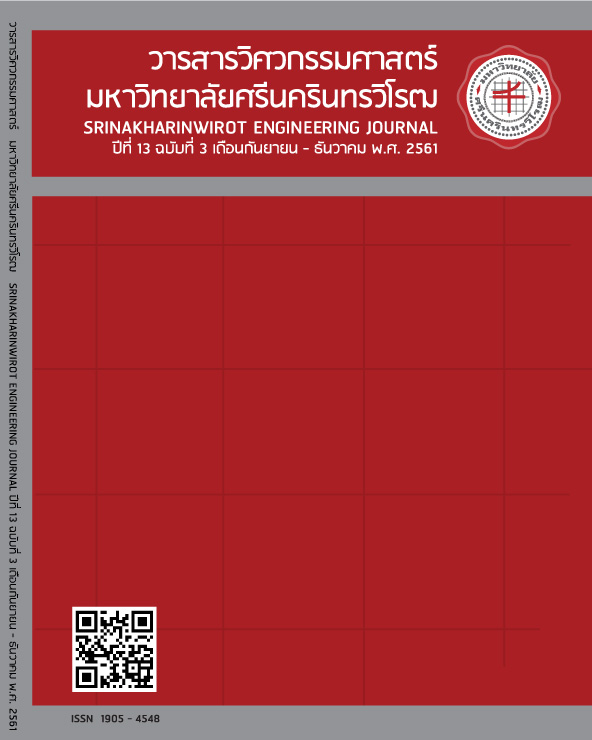Effect of Bending Load on the Creep Deformation Behavior
Main Article Content
Abstract
The purpose of this research is to study the creep deformation behavior of the Bambusa blumeana. The study was carried out by restraining the bamboo beam under moisture condition and constant temperature. Three level of loads were applied to the specimens respectively i.e.,—10%, 20% and 30%—of the maximum load. Each level of load was applied for 4 hours. It was found that when the testing objects were loaded, their shape suddenly changed and continued changing slowly as time increased. The maximum value at the end of the testing time. Moreover, the Bailey-Norton Creep Law successfully describes the main feature for the investigated material and shows good agreement with experimental creep data with R2 more than 0.994.
Article Details
Copyright belongs to Srinakharinwirot University Engineering Journal
References
[2] S. Phumiphamon, “Bamboo with the Local Community Way in Thailand,” in Proceeding of the 1st Bamboo and Livelihoods in Thailand: Local Knowledge and Management. Bangkok, 2014, pp. 19-27.
[3] J. Bodig and B.A. Jayne, “Mechanics of Wood and Wood Composites,” Krieger Publishing Company. Malabar, Florida, 1993.
[4] T. Ounjaijom and W. Rangsri, “Creep behavior of the bamboo (Dendrocalamus Hamiltonil),” in Proceeding of the 26th ME-NETT Conference of Mechanical Engineering Network of Thailand, Dusit Thani Resort, Chiang Rai, Thailand, 2012, pp.72.
[5] T. Ounjaijom and W. Rangsri, “Burgers model parameter identification of bamboo creep behavior,” in Proceeding of the 4th TSME International Conference on Mechanical Engineering, Chonburi, Thailand, 2013, pp. 86.
[6] T. Ounjaijom and W. Rangsri, “Numerical and experimental study of the transverse creep-recovery behavior of bamboo culm (Dendrocalamus hamiltonii),” Walailak J. Sci. Technol., vol. 13, no. 8, pp. 615-629, 2016.
[7] J. Tissaoui, “Effects of long-term creep on the integrity of modern wood structures,” Ph.D. dissertation, Civil Engineering, Virginia Polytechnic Institute & State University, 1996.
[8] M. Yahyaei-Moayyed and F. Taheri, “Experimental and computational investigations into creep response of AFRP reinforced timber beams,” Compos. Struct., vol. 93, no. 2, pp. 616-628, 2011.
[9] Y. Xu, S.-Y. Lee and Q. Wu, “Creep analysis of bamboo high-density polyethylene composites: effect of interfacial treatment and fiber loading level,” Polym. Compos., vol. 32, no. 5, pp. 692-699, 2011.
[10] International Standard, Determination of Physical and Mechanical Properties of Bamboo, ISO/DIS 22157, 2004.
[11] M. Nakagima, K. Kojiro, H. Sugimoto, T. Miki and K. Kanayama, “Studies on bamboo for sustainable and advanced utilization,” energy, vol. 36, no.4, pp. 2049-2054, 2011.
[12] R.S. Lakes, “Viscoelastic Materials,” CRC Press, Boca Raton, Florida, 2009.
[13] S.L. Campbell, J.P. Chancelier and R. Nikoukhah, “Modeling and Simulation in Scilab/Scicos,” Springer, New York, p. 113-117. 2006.
[14] Pramote Dechaumphai, “Numerical Methods in Engineering,” 9th ed., Chulalongkorn University Press, Bangkok, 2014.

